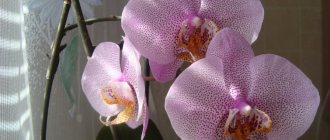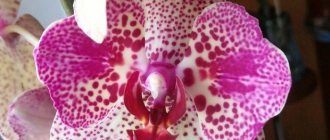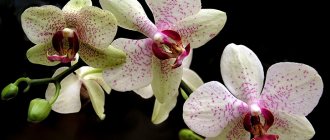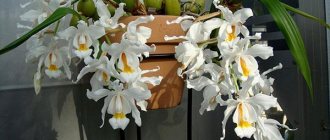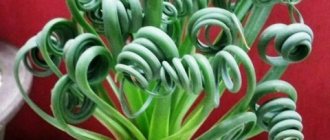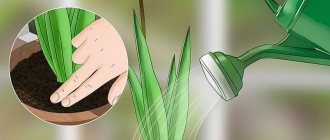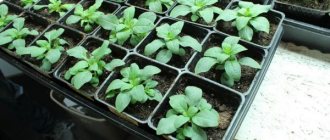The beautiful orchid flower amazes with its magnificence; this genus of plants has about 30 thousand species, of which the rarest is Dendrophylax Linden. This unique plant is also called “Ghost”.
This species received its name due to the structural features and location of its growth. In the tropics, in swampy areas, you can find a white flower “floating” in the air. The Linden orchid performs this trick thanks to its system of structure and life activity, namely: the open root system is attached to another vertical plant, often a tree, as a support. Then it produces its long, thin peduncles, on which the miracle of flowering occurs. This way it looks like a white bud hanging in the air.
Detailed description and photo
The scientific name of the Ghost in Latin is Dendrophylax lindenii or Polyrrhiza lindenii . The flower received its name in honor of its discoverer, Jean Jules Linden.
You can often hear the following plant names:
- Dendrophylax.
- Polyriza.
- Linden.
Root system
As already mentioned, Lindena's root system is open, and the plant itself has no leaves . It is the root system that takes over the function of photosynthesis; it also absorbs oxygen, moisture and nutrients. The color of the roots is gray-green.
The roots are smooth, rather thick and long. The length can reach more than 50 cm, and the thickness is approximately 5 mm.
Bud
Orchid buds are beautiful. The shape of the petals will attract the attention of even those who are not at all interested in flowers. These are three beautiful white petals sitting on three sepals. The lip, as the central petal of orchids is called, is greatly enlarged and has a very interesting shape. This shape forms three blades, two of which are elongated and hang down like the legs of a frog. This common comparison gave Dendrophylax another name: frog orchid .
The size of the bud in diameter is 3-4 cm, and from top to bottom it can reach up to 15 cm.
Stems
The stems are thin, almost invisible, reaching a length of up to 40 cm.
Hawaiian bog orchid
This velvety-petalled orchid is one of three species that grow in the Hawaiian Islands in swamps, in areas inaccessible to local wild boars.
Its Latin name is Platanthera holochila, which means it is part of the genus Platanthera.
Its pale green leaves are ovoid in shape and its greenish-yellow flowers appear on open spines.
Differences from other orchid species
- Leafless existence. It should be noted that at the early stage of development of Polyrhiza, leaves still grow, but during the development of the plant they disappear.
- Open root system, epiphytic lifestyle.
- Large buds, very large and unusual lip (middle petal).
- Until recently, the frog orchid was considered an extinct plant; to this day it remains a rare specimen.
By the way, it was previously believed that the Ghost is a parasitic plant , that is, it draws all resources from the plant to which it is attached. Today, experts claim that the union of Lindena and another plant is symbiotic, or rather the ghost has a symbiosis with mycorrhizal fungi, which supply the plant with nutrients.
Peculiarities of flowering of the Phantom orchid, dormant periods
The duration of one flowering of Phalaenopsis Phantom, depending on care and growing environment, varies from 3 to 6 months. This period is also determined by the number of peduncles and the condition of the flower. If it is strong, not susceptible to pests and diseases, with a well-developed root system and healthy leaf blades, then flowering can last as long as possible.
Advice! If the plant is young and is just beginning to shoot arrows and open buds, then after the first or second flowering, experts recommend artificially creating conditions for a dormant period. This is necessary so that the flower can accumulate enough strength and resources for a new, even more magnificent and long-lasting flowering.
Like wild orchids, domestic specimens do not have a pronounced dormant period. Phalaenopsis on the windowsill is able to grow and develop all year round. The only condition for this is proper care.
When and how does flowering occur?
Lindena blooms from late winter to early spring, however, this beautiful plant does not bloom every year. It begins several years after seed germination.
What it looks like:
- From a shortened stem in the center of the plant, thin and strong flower stalks sprout, diverging to the sides, from 1 to 10 per plant. Peduncles reach 25 cm in length. By June-August, one flower appears on each peduncle. Flowering lasts about three weeks.
- During the flowering period, the petals of the flower bend back, and the lip is pulled inward and turns into a 12-centimeter hanging spur, which is filled with nectar.
- Interestingly, during flowering the color of the petals changes from white to pale green, while the lip remains white.
- The buds exude a bright apple aroma.
Yellow – purple lady slippers
Yellow and Purple Lady Slippers were found in London and some other areas of Europe.
The combination of yellow and purple on one flower is extremely rare in nature, making these orchids not only one of the rarest, but also one of the most expensive flowers in the world.
The reason why the orchid has become rare: extinction due to human deforestation and sheep grazing.
A protected species in the UK since 1975 under the Wildlife and Plants Act.
Caring for a plant at home
Pots for growing ghost orchids are absolutely not suitable. To grow dendrophylax it is necessary to create a so-called orchidarium .
Here's what you need for this:
- Rectangular container like an aquarium.
- Phytolamp.
- Thermometer.
- Hydrometer.
- Wire mesh.
- Ventilation system.
- Moss, expanded clay and peat.
- A piece of wood.
How to create an orchidarium:
- The inside of the three walls of the aquarium are lined with mesh, to which blocks with plants will be attached.
- Moss is placed at the bottom, which needs to be well moistened.
- A fan and lamp are attached to the cover.
- A thermometer and a hydrometer are attached to the walls.
- The plant is carefully attached to the wood using a soft tape and installed in the archidarium.
Necessary conditions for cultivation:
- The temperature during the day should be 30-33 degrees, and at night 20-23 degrees.
- Humidity not less than 80%.
- Regular but not frequent ventilation.
- Scattered light.
- Presence of mycorrhizal mycelium in the substrate.
Water regularly, once a week, the water should be soft, melt or rain water is ideal. It is important to ensure that the water does not stagnate or remain on the roots, but also not to allow it to dry out.
Fertilizing is done along with watering; it is recommended to use 1/4 of the dose indicated in the instructions.
In spring, the orchid begins a resting phase, which lasts until the end of autumn. During this period, it is important to change the temperature: 25 degrees during the day, 12 degrees at night. At this time, it is necessary to reduce watering and fertilizing for several weeks.
Reviews
Anna. “I’ve been growing phalaenopsis for many years, but I wouldn’t dare to have such a miracle at home. I don't think there's enough room for it. Although I would really like to try to grow it. Where to buy it and how to find a place for a terrarium in our small apartments..."
Larisa. “What is there in nature! You don't often see such a miracle. All that remains is to admire it in photographs on the Internet.”
Igor. “I was in Florida and had the opportunity to purchase the “Ghost.” But processing documents for export is too expensive and time-consuming. But I didn’t want to spend about 200-300 euros on the fact that it would at least develop and not die within a year. In real life, the ghostly orchid looks impressive. Really like ghosts. Especially at the end of the day, when dusk sets in, the flowers hang in the air like white frogs. A fascinating sight."
Diseases and pests
Such a rare plant does not provide the opportunity to conduct disease analysis . Even very experienced flower growers often do not understand the reasons for the death of their exotic beauty.
Prevention consists of maintaining optimal conditions and properly caring for the flower.
In conclusion, I would like to encourage those who wish to have such a rare plant in their collection. Breeding scientists are actively working on the problem of growing ghosts at home. It is quite possible that very soon we will see hybrids suitable for home cultivation. In the meantime, you can visit special nurseries or botanical gardens abroad.
Peristeria elata or Orchid-Dove
This unusual and rare orchid is called the Holy Spirit Orchid.
All over the world, the flowering of this orchid is associated with the onset of prosperous peacetime. Its white, waxy flowers resemble a snow-white dove taking off - a recognized symbol of peace.
Due to the beauty of the flowers that shelter the bird inside, the flower has almost disappeared from the wild. You need to be incredibly lucky to see it in its homeland - Central America.
The flowers of Peristeria tall are snow-white with lilac or purple spots. Nature formed the petals, pistils and stamens of this orchid in such an amazing way that they resemble a dove.
The Holy Spirit Orchid is considered a symbol of peace , and in Panama this flower is national and protected by the state.
Recommendations
- UKTV Viewer Requests. Plants behave poorly. Murder and mayhem. Blue Ray. UPC 4006448510039
- ^ a b
Juliet Jovit (8 March 2010). "The Ghost Orchid Returns from Extinction." The keeper. - ^ a b
Ghost Orchids - fleeting appearance in dark, shaded woods, 3 July 2013, Museum of Wales, accessed 21 August 2016. - ^ a b
Melanie Roy;
Takahiro Yagame; Masahide Yamato; Koji Iwase; Christine Heinz; Antonella Faccio; Paola Bonfante; Marc-André Selosse (2009). "The ectomycorrhizal Inocybe
species is associated with the mycoheterotrophic orchid
Epipogus aphyllum
but not its asexual propagules."
Annals of Botany
.
104
(3):595–610. doi:10.1093/aob/mcn269. PMC 2720653. PMID 19155220. - "Epipogium aphyllum - Italian flora." luirig.altervista.org
. Retrieved September 4, 2022. - "Epipogium aphyllum in the flora of China @ efloras.org." www.efloras.org
. Retrieved September 4, 2022. - Taylor, Lin; Roberts, David L. (4 September 2011). "Biological flora of the British Isles: Epipogium aphyllum Sw". Journal of Ecology
.
99
(3):878–890. Doi:10.1111/j.1365-2745.2011.01839.x.
Strongylodon Carpal
The green-blue branch with claw-shaped flowers has long been considered a rarity, although it is a common relative of our beans, in the legume family. The jade vine was discovered in the Philippines in 1937, and 20 years later it was widely cultivated in botanical gardens. In nature, it is pollinated by bats, hanging on the bunches and drinking nectar, therefore, due to changes in their habitats, Strongylodon Carpal is practically never seen in the wild.
The incredible claw-shaped flowers come in a variety of shades, from soft mint to dark green. The brushes reach a meter in length and can have up to 100 flowers. To attract pollinators, jade vines glow in the dark, so it is best to visit botanical gardens in the late afternoon.
